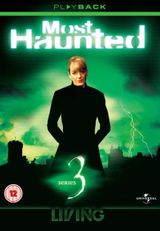
Most Haunted 3
2003-10-07 | Documentary,Mystery | 10 episodes24 Seasons
Episode
RAF East Kirkby (2003)
Work started on the construction of the airfield in 1942 and by the middle of 1943 East Kirkby's runways were operational and 57 Squadron, equipped with Lancasters, arrived. During November 1943, 630 Squadron was formed and also remained at East Kirkby for the duration of the war. The number of servicemen and women stationed at East Kirkby soon exceeded the 2,000 level. East Kirkby's aircraft suffered losses in the Berlin and Nuremberg raids, but its worst night was 21 June 1944 when 11 aircraft were lost in an attack. Towards the end of the war, in April 1945, a Lancaster caught fire while being bombed up, resulting in a huge explosion which set off further bombs. Four people were killed, six Lancasters totally destroyed, and a further fourteen damaged. In the post-war period, the airfield was used for trials and for a short time during the mid-1950s it was occupied by United States Air Force. Eventually closing in 1958, the RAF finally disposed of the site in 1970. In recent years du

Moresby Hall (2003)
Overlooking the Cumbrian fells, Moresby Hall has been home to many noble families since the 12th Century - it is the oldest residence in the Copeland borough (West Cumbria) and a Grade I listed building. The name Moresby is likely to have derived from a connection with a settler (probably called Morisceby, Mawriceby or Moricebi) as early as 1150. The Moresby family were notorious in the medieval times, and aquired large estates through conquest and marriage. One of the most famous, Christopher de Moresby, fought at Agincourt and was honoured on the field with other knights by King Henry. Four generations of de Moresby later, Anne, Sir Christopher's great grand-daughter was sole heiress. She married Sir Francis Weston, who was executed by King Henry VIII, along with Queen Anne Boleyn and another of her alleged paramours. Anne finally sold Moresby Hall to a well-to-do merchant from Cockermouth - William Fletcher. The Fletchers were also a powerful family and owned Moresby Hall for 250 y

Edinburgh Vaults (2003)
Edinburgh's South Bridge was built in 1785-88 to cross the valley between the High Street and George Square. Beneath the 19 enormous stone arches, a series of floors and walls were constructed to create a series of underground vaults. These were used by local shops and businesses as workshops and storage space. They also provided family accommodation – but it was far from luxurious. Groups of ten or more people lived together in small, dark, dank rooms. They had no ventilation and with the stench of fish oil lamps, stale rubbish and the contents of chamber pots emptied into the streets, living conditions must have been almost intolerable. It wasn't long before the vaults also became the worldly haunt of a collection of the city's rogues, villains, prostitutes – and murderers. The vaults were sealed off and completely abandoned in 1815 and weren't rediscovered until 1985 - and since then, numerous ghostly sightings and experiences have been reported. Several people have reported a young

Leith Hall (2003)
James Leith built the first tower of what was to become known as Leith Hall in 1650. Since then subsequent Lairds have added to it so that now it is one of the finest examples of the ‘chateau' style castles in Scotland. It also boasts some of the finest gardens in Scotland within the 113 ha estate. The Hall is also one of the few Scottish castles to stay in the same family as it has been passed from father to son. The family itself had very strong military connections and the hall was a major stronghold in the Jacobite Rebellion of 1745-1746 with close ties to Bonnie Prince Charlie. On the eve of the fateful Battle of Cullodon, the Laird, Andrew Hays, was presented with a writing case by the Prince which is still in the museum. The museum also contains the only pardon ever given to a Jacobite by the English after the battle. In keeping with the Hall's military background, it was converted into an army hospital during The Great War. Tragedy struck in 1939 when the last two Lairds were k

Aberglasney House (2003)
During the Middle Ages, the area around Aberglasney was the centre for bloody battles, including a particularly violent offensive in 1257. Nearby fields still carry the memories with names such as Cae Tranc (field of vengeance) and Cae'r Ochain (groaning field). Until the fifteenth century we depend on tradition for our knowledge of the people who owned Aberglasney. From that point onwards the property was sold to a different family roughly at the start of each new century and a strange seesaw pattern of wealth alternating with misfortune emerging. The documents are missing, but Bishop Rudd is generally thought to have acquired the Aberglasney estate sometime around 1600. The house stayed in the family until 1710 when accumulated debts forced Sir Rice, the Bishop's grandson, to sell the estate to Robert Dyer. His grandson Robert Archer Dyer inherited in 1752 but already Aberglasney was once again draining the family coffers and finally Aberglasney was put up for sale in 1798. In 1803 T

Cast
View Live Cast Profile
Photo






